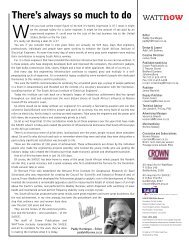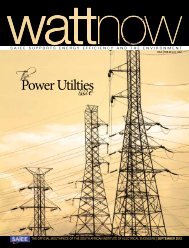download a PDF of the full January 2012 issue - Watt Now Magazine
download a PDF of the full January 2012 issue - Watt Now Magazine
download a PDF of the full January 2012 issue - Watt Now Magazine
- No tags were found...
Create successful ePaper yourself
Turn your PDF publications into a flip-book with our unique Google optimized e-Paper software.
The Swimming Pool Pumpthat will turn <strong>the</strong> pool water around forfiltering purposes, and in <strong>the</strong> extreme avariable speed pump with digital controlcan be set to run continuously at verylow speed/power, and to only speed upoccasionally for a short period to operate<strong>the</strong> automatic cleaner, which needs at least100 <strong>Watt</strong> to function. See results fur<strong>the</strong>ron, <strong>of</strong> an experiment to determine howlong such a cleaner needs to run daily.Comparative energy use figuresNote that <strong>the</strong> key effect here is variablespeed, and not motor efficiency, whichcontributes only a minor share tominimising energy for pumping a fixedvolume <strong>of</strong> water.Also very significant is <strong>the</strong> “unintendedenergy demand result” <strong>of</strong> automatedsanitisers like salt water chlorinators, UVexposure, and oxygenator/ionisers, whichprescribe varying, but long, periods <strong>of</strong>water flow irrespective <strong>of</strong> <strong>the</strong> strength andconsequential energy usage <strong>of</strong> <strong>the</strong> pump.A minimal energy pump setting seems tobe <strong>the</strong> answer to this dilemma, and willenable total eco-friendly swimming poolsthat have very small carbon footprint, andchemicals-free water.A long term experiment withfiltering and automatedcleaner time periodsBecause it is difficult to find out whyprivate pool owners are advised to run<strong>the</strong>ir automatic cleaners and filters for somany hours every day, it could be helpfulto look at an 8 month history (half a winter+ half a summer) <strong>of</strong> a medium-sized pool(50 000 litres) in a city garden, where afocused effort was made to maintain it to asimilar standard as neighbourhood pools,but using 5 % <strong>of</strong> <strong>the</strong> energy, or less.Basically energy is required to sweep orsuck <strong>the</strong> bottom clean and deposit <strong>the</strong> wastematerial (dust/sand, leaves, dead algae)into a strainer or filter. It is also necessaryto circulate water through a fine filter36 | wattnow | january <strong>2012</strong>Daily operation <strong>of</strong> filter pump, and monthly energy usage, Kwh/monthNote 1 This is <strong>the</strong> power consumption <strong>of</strong> <strong>the</strong> variable speed Badu Eco Touch on its LOWsetting. The motor efficiency is > 90%Note 2 This is <strong>the</strong> marked output power <strong>of</strong> <strong>the</strong>se conventional induction motors, wi<strong>the</strong>fficiencies varying from < 70% to around 80%, depending on size.(most commonly sand) to catch suspendedparticles. An automatic pool cleaner wasattached during this experiment, but noo<strong>the</strong>r devices. Sanitising and algae controlwas done manually. The same adjustable3-speed pump was used for <strong>the</strong> experiment,and it was found that <strong>the</strong> lowest setting(300 <strong>Watt</strong>) could still drive <strong>the</strong> pool cleanerwith vigor, with a circulation <strong>of</strong> 7300 l/hourthrough <strong>the</strong> system.In summary: a 300 <strong>Watt</strong> pump is sufficient todrive a pool cleaner system for long periods,but if <strong>the</strong> pool is in a bad shape, it will need<strong>the</strong> medium or high setting and a few backwashingsto clear it up first. The cleanermoves at a speed <strong>of</strong> 4 meter/min across <strong>the</strong>bottom, and can <strong>the</strong>oretically sweep <strong>the</strong>pool in less than 30 minutes. In practice,with some prodding not to skip some areas,one hour is sufficient. The clarity <strong>of</strong> <strong>the</strong> waterwas as good as that <strong>of</strong> neighbouring poolsthat filtered for extensive periods daily. Itwas thus demonstrated over a prolongedperiod (8 months) that it is possible tomaintain this pool, running <strong>the</strong> filter pumpfor only one hour per day, on average, andusing less than 10 kWh/month.To appreciate <strong>the</strong> significance <strong>of</strong> this, <strong>the</strong>table below displays <strong>the</strong> range <strong>of</strong> energycost across different sizes and types <strong>of</strong> pumpmotors, run for different daily periods.The bottom line is <strong>the</strong>refore that <strong>the</strong> energycost <strong>of</strong> a domestic swimming pool can bereduced dramatically without sacrificingwater quality, and for some installations<strong>the</strong> price differential between mature*2and new*1 pump motor technology canbe recouped in less than a year, dependingon requirements. It has been shown thatlong hours <strong>of</strong> swimming pool filtering andautomatic cleaner operation to maintainclean internal surfaces and clear water isunnecessary and wasteful in energy usage.A low power pump motor (300 <strong>Watt</strong>) candrive a cleaner as effectively as a strongmotor (1100 <strong>Watt</strong>), and one hour's operationper day can be sufficient for a medium-sizeddomestic swimming pool (50 000 liters). Ifpool chemicals are manually administered,no extra pump time is required, and <strong>the</strong>monthly energy requirement to maintain<strong>the</strong> swimming pool, can be as low as 10kWh. If in-line sanitising is implemented,additional energy will be consumed, becauselonger water circulation times are required,but in view <strong>of</strong> <strong>the</strong> previous analysis <strong>the</strong>re ishope that this unintended energy demandcan also be drastically reduced, to <strong>the</strong> samelevel as that <strong>of</strong> <strong>the</strong> automatic cleaner.In final analysis: <strong>the</strong> stage is set for <strong>the</strong>domestic swimming pool to become morefrugal in energy usage (< 50 Kwh/mo) than<strong>the</strong> family fridge, and simultaneously more
















